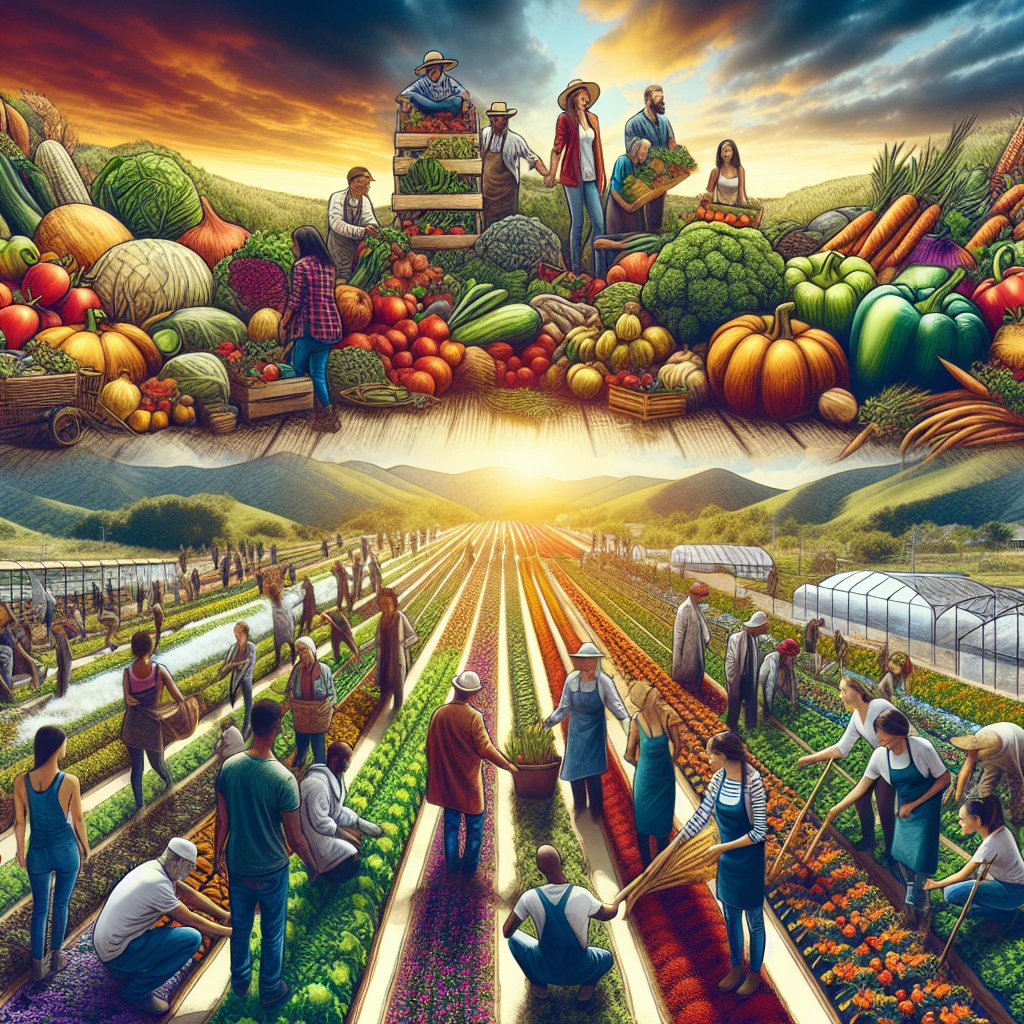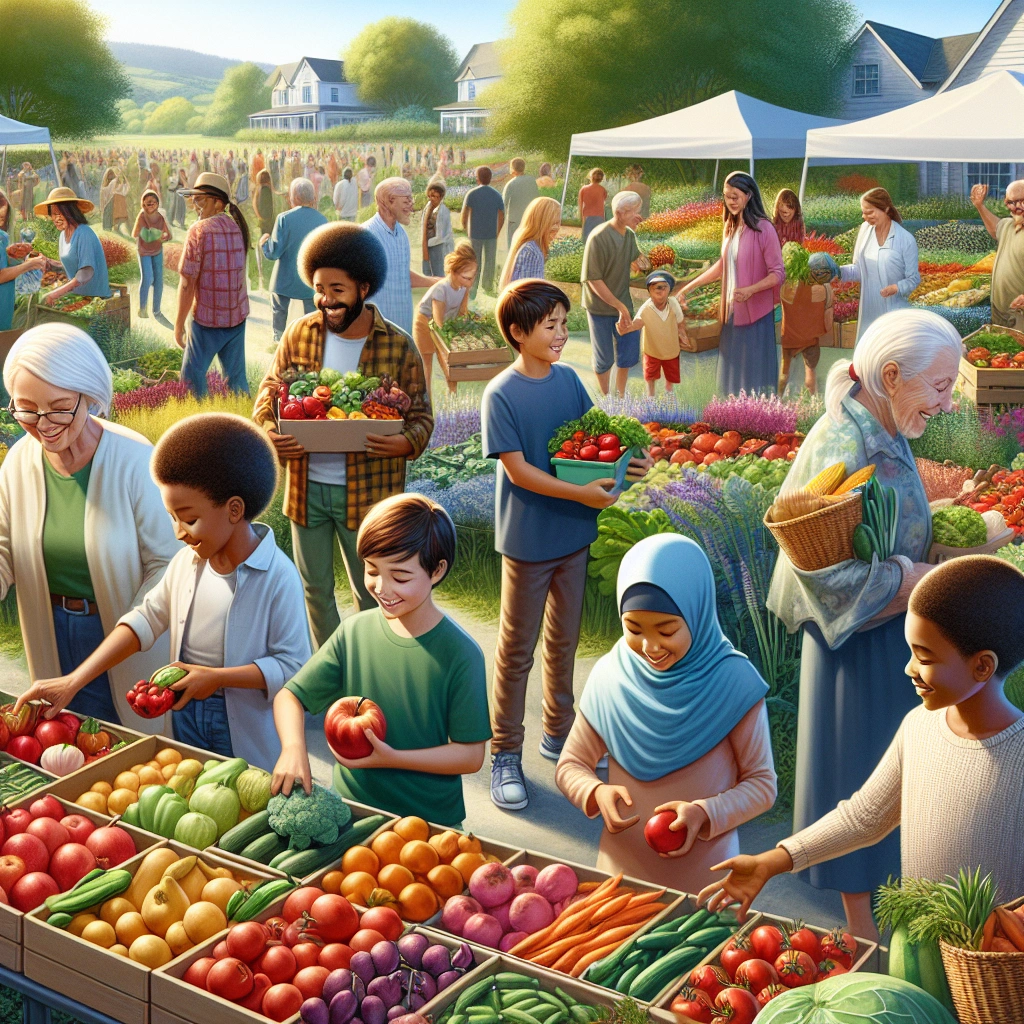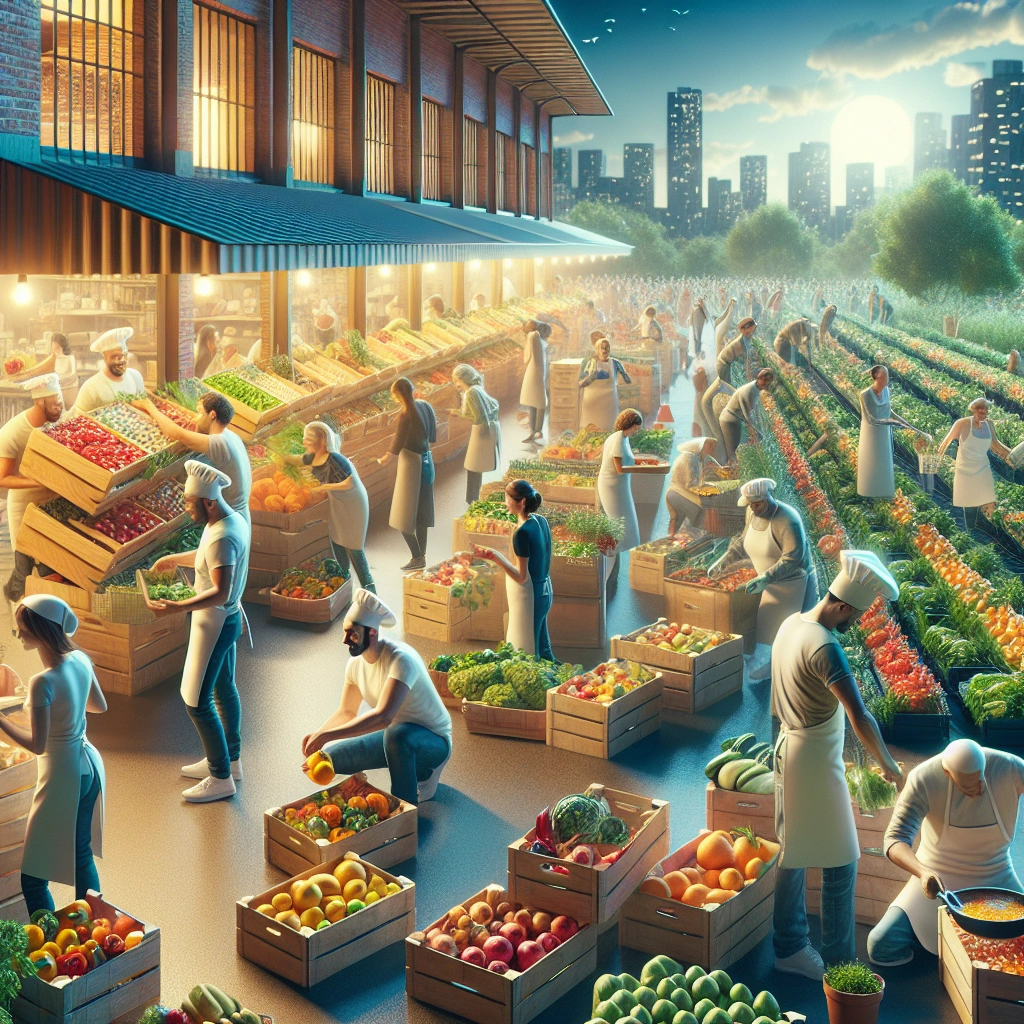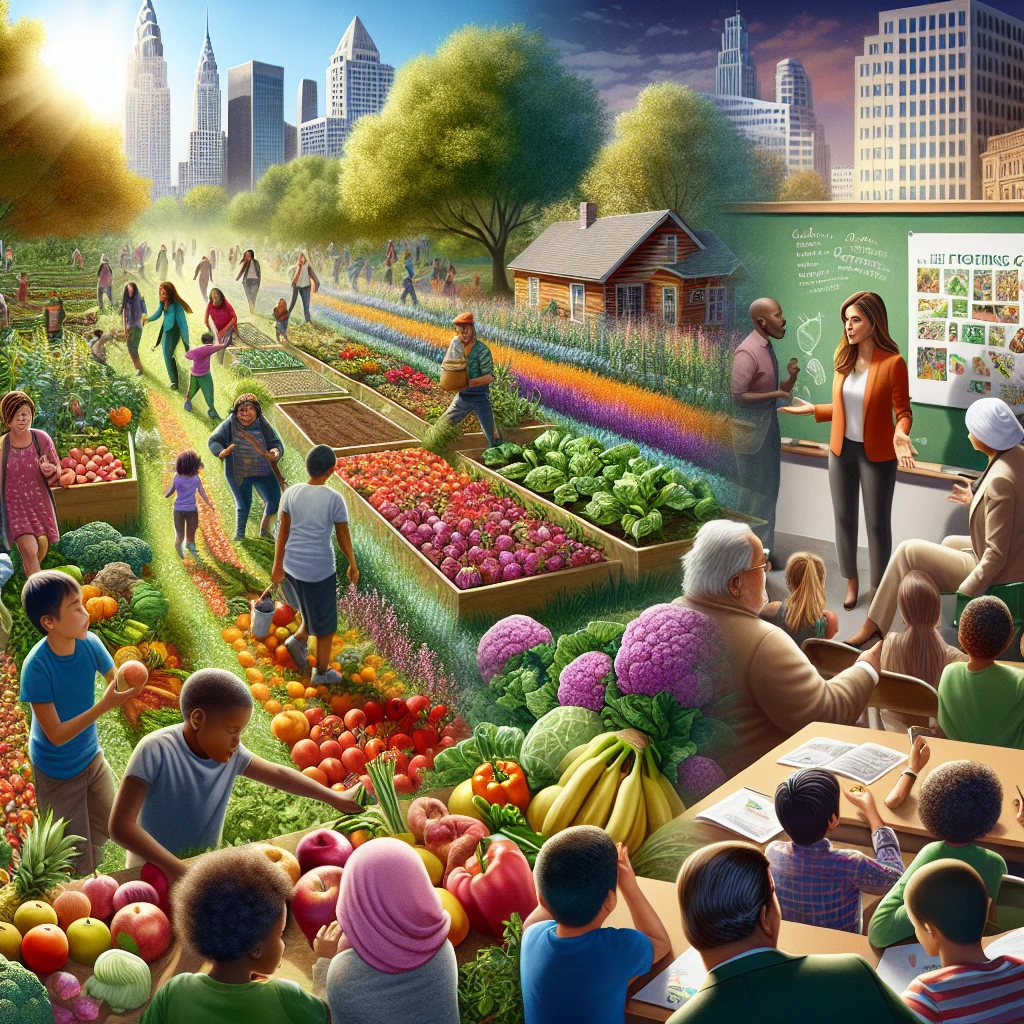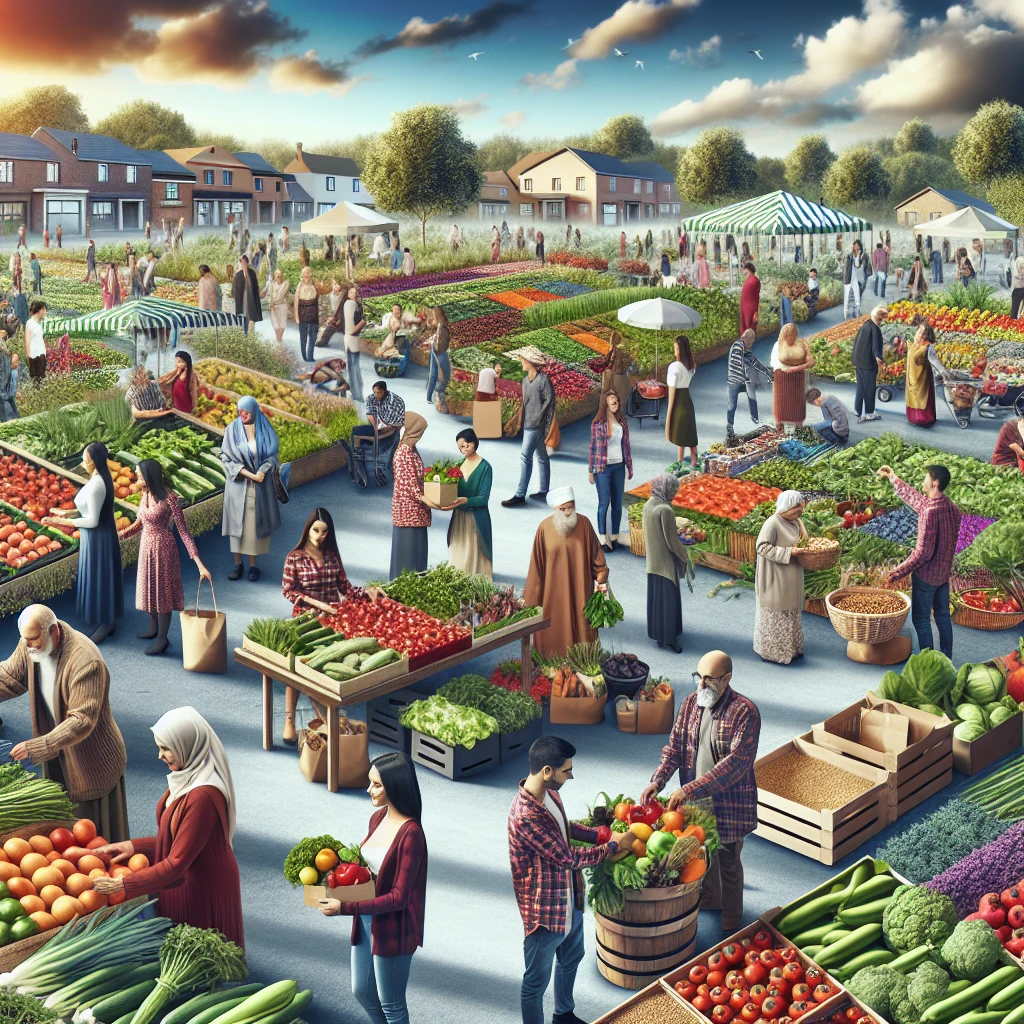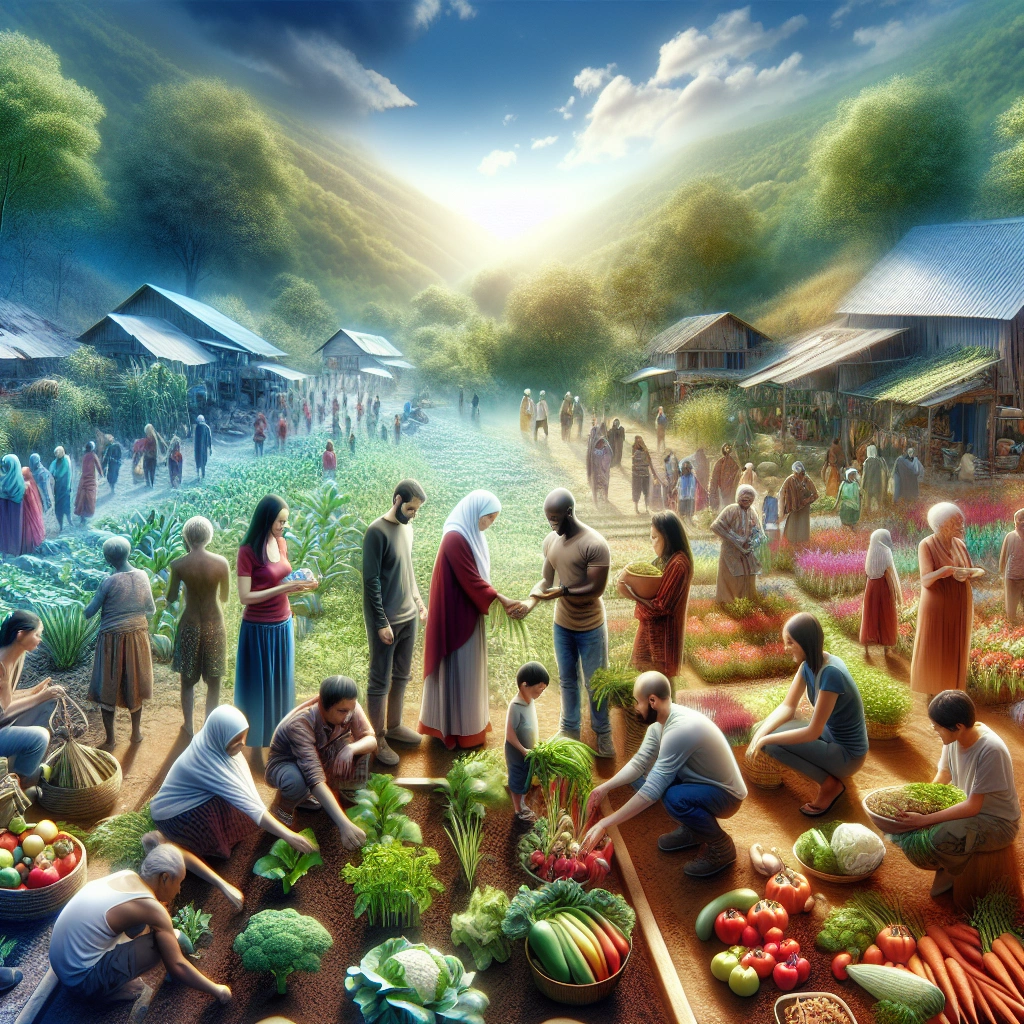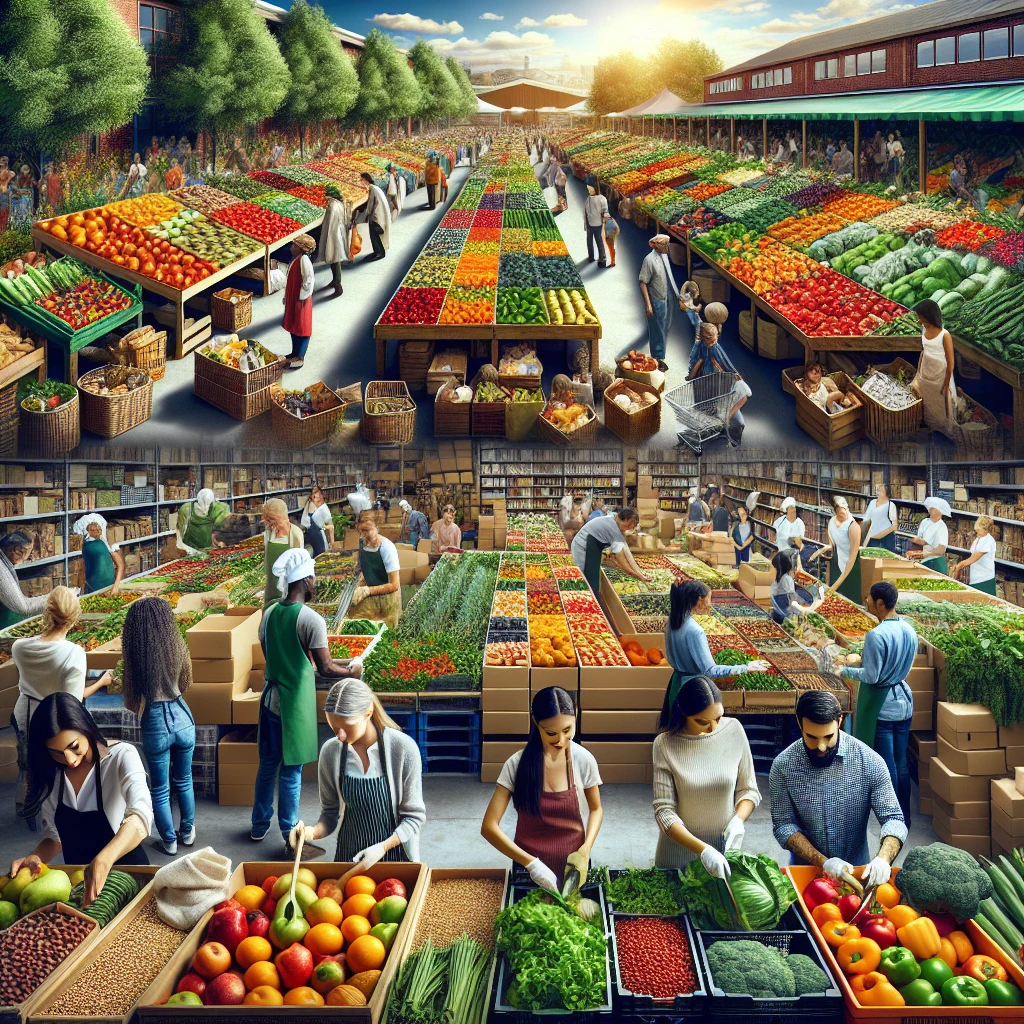

The global food crisis refers to the widespread shortage of food, leading to chronic hunger for as many as 783 million people. This crisis is caused by a combination of factors such as conflict, climate extremes, economic shocks, and soaring fertilizer prices.
The impact of the food crisis is devastating, with weather extremes, armed conflict, and economic shocks creating a situation where hunger will spiral out of control if immediate action is not taken. The current hunger crisis is different because there is a shortage of both agricultural outputs and inputs, such as water and fertilizer.
Finding sustainable food crisis solutions is essential to addressing the global hunger crisis. Promising sustainable food sources, including insects, cultured meat, fungi, algae, and plants, have emerged as potential solutions to the food crisis.
It is crucial to implement sustainable approaches to address the global food crisis and alleviate the suffering of millions facing chronic hunger.
Check out this Youtube video: “Multiple-Win Solutions to the Global Food Crisis” for innovative and practical ideas to address the food crisis and create a sustainable future for our planet.
Understanding the Food Crisis
Factors contributing to the global food crisis
The global food crisis is influenced by various factors, including poverty, conflict, extreme weather, and economic shocks. These factors intersect to create a complex web of challenges that impact food production, distribution, and accessibility, exacerbating hunger and food insecurity.
Impact of climate change on food production
Climate change significantly affects food production, leading to both positive and negative impacts. While moderate warming and increased carbon dioxide levels can enhance plant growth, severe warming, floods, and droughts can drastically reduce yields.
Additionally, livestock face direct heat stress and reduced food quality due to climate change, further impacting food production.
The role of poverty and inequality in exacerbating food insecurity
Poverty and inequality play a crucial role in exacerbating food insecurity, especially among vulnerable populations. The association between poverty and food insecurity among children is evident, as compromised food quality and hidden hunger contribute to worsening malnutrition in impoverished communities.
| Aspect | Impact |
|---|---|
| Poverty | Exacerbates food insecurity |
| Climate Change | Alters food production dynamics |
| Conflict | Disrupts food distribution |
| Extreme Weather | Impacts crop yields |
| Inequality | Compromises food accessibility |
Understanding the food crisis necessitates acknowledging the multifaceted nature of its causes, encompassing poverty, climate change, and inequality. Addressing these fundamental factors is essential to implementing effective food crisis solutions and achieving sustainable global food security.
Historical Context
Historical examples of food crises and their impact
During the late nineteenth century, countries such as India, China, Korea, Brazil, Russia, Ethiopia, and Sudan experienced devastating famines, resulting in up to fifty million deaths. These crises were fueled by global factors, including conflicts and climate impacts, leading to soaring food and fuel costs, and significantly affecting millions of lives.
Lessons learned from past food crises and their relevance to the present situation
Reflecting on past food crises, it’s crucial to acknowledge the impact of market reliance versus government intervention in addressing food security. The 2007-2008 food crisis indicated the significance of cooperation between nations and the avoidance of export bans to mitigate future crises.
Furthermore, the key lesson from the current food crisis emphasizes the need for countries to prioritize domestic self-sufficiency in staple food production to enhance resilience.
Current State of Global Hunger
Statistics on the number of people affected by food insecurity
According to the United Nations’ latest report, the number of people affected by hunger globally rose to as many as 828 million in 2021, an increase of about 46 million since 2020 and 150 million since the outbreak of the COVID-19 pandemic. These alarming statistics underscore the urgent need for concerted efforts to address food insecurity on a global scale.
Challenges faced by developing and developed countries in addressing hunger
Developing and developed countries face unique challenges in addressing hunger. Developing countries often struggle with the modernization and industrialization of agriculture, necessitating urgent investment in early warning systems, climate change response measures, and social protection initiatives.
Conversely, developed countries grapple with household food insecurity linked to economic inequality. Moreover, both groups confront common obstacles, including climate change impacts, population growth, and food waste, necessitating a comprehensive, collaborative approach to combatting global hunger.
| Developing Countries Challenges | Developed Countries Challenges |
|---|---|
| Modernization of agriculture | Household food insecurity |
| Investment in early warning systems | Economic inequality |
| Social protection measures | Impact of climate change |
| Addressing climate change impacts | Population growth |
This table illustrates the distinct challenges faced by developing and developed countries in dealing with food insecurity, highlighting the diverse nature of the global hunger crisis.
Feel free to let me know if you need more details on the same.
Importance of Sustainable Agriculture
Implementing sustainable farming practices
– Implementing sustainable farming practices is crucial for addressing food crisis solutions. By utilizing methods such as crop rotation, integrated pest management, and agroforestry, farmers can optimize land use, reduce environmental impact, and enhance crop resilience against climate change.
Promoting agroecology and organic farming to improve food security
– Promoting agroecology and organic farming plays a significant role in bolstering food security. These practices focus on maximizing ecological processes to maintain productive and resilient agricultural systems. By prioritizing biodiversity, minimizing chemical inputs, and enhancing soil health, agroecology and organic farming contribute to sustainable food production.
Access to Nutritious Food
Food deserts are geographic areas where residents have limited access to affordable, healthy food options, especially fresh fruits and vegetables, due to the absence of grocery stores within convenient traveling distance. This lack of access to nutritious and diverse foods disproportionately affects low-income communities, leading to food insecurity and its associated health issues.
Addressing food deserts and the lack of access to fresh produce in certain communities requires a multi-faceted approach. Firstly, it involves the need for governmental, private, and grassroots support to solve this complex problem.
This includes bringing grocery stores back into neighborhoods where they are missing, offering better public transportation to get people to and from the market, and implementing ways to grow fresh food closer to the consumers who eat it.
Furthermore, community-based solutions play a crucial role in improving access to affordable, healthy foods in food deserts. Initiatives such as local markets, community gardens, and surplus food distribution programs can help bridge the gap and ensure that all individuals have access to nutritious food options.
By promoting food security through local initiatives, these communities can work towards overcoming the challenges posed by food deserts and create a sustainable, healthier environment for all.
Food Waste and Distribution
Addressing issues of food waste in developed countries
In developed countries, addressing food waste is crucial to combatting the global food crisis. It involves implementing efficient food management practices at every stage of the supply chain, from production to consumption.
For instance, utilizing advanced technology for inventory management and implementing policies to incentivize food donations to reduce waste can significantly impact the overall food sustainability efforts.
Improving distribution systems to ensure equitable access to food
Improving distribution systems is essential to ensure equitable access to food, especially in underserved communities. This encompasses initiatives such as establishing community food-growing spaces, implementing land use or zoning ordinances to allow healthy food production and sales, and creating educational programs and policies to raise awareness about the significance of reducing food waste.
These efforts align with the goal of creating a sustainable and fair food system that benefits all individuals, regardless of their socioeconomic status or geographical location.
| Initiatives | Impact |
|---|---|
| Advanced Technology for Inventory Management | Minimizes food loss in storage and transportation |
| Policy Incentives for Food Donations | Reduces waste and supports food sustainability |
| Community Food-Growing Spaces | Increases access to fresh, locally grown produce |
| Educational Programs and Policies | Raises awareness and promotes responsible consumption |
By focusing on these aspects and implementing innovative strategies, we can work towards minimizing food waste and enhancing the distribution of food resources to address the ongoing food crisis.
Innovative Technological Solutions
Technology plays a crucial role in improving food production and distribution. One revolutionary advancement is precision agriculture, utilizing sensors and drones to monitor crops, leading to increased yields and decreased waste.
Additionally, simulation software can optimize logistics, mitigate supply chain disruptions, and foster sustainable agriculture, positively impacting global hunger. Furthermore, the Internet of Things (IoT) has enabled the implementation of sensors for irrigation and crop monitoring, enhancing productivity and resource management on farms.
These technological solutions have proven instrumental in addressing food crises and promoting sustainable food practices.
Utilizing technology to improve food production and distribution
Innovative technological solutions, such as precision agriculture, simulation software, and IoT-enabled sensors, have significantly improved food production and distribution by enhancing crop yields, minimizing waste, and optimizing resource management on farms. These advancements play a vital role in addressing food crises and promoting sustainable farming practices.
Examples of successful technology-driven food crisis solutions
One prominent example of a successful technology-driven food crisis solution is the use of precision agriculture, which harnesses sensors and drones to monitor crops, resulting in increased yields and reduced waste. Similarly, simulation software has been crucial in optimizing logistics, mitigating supply chain disruptions, and fostering sustainable agriculture, contributing to hunger reduction globally.
The implementation of IoT-enabled sensors for irrigation and crop monitoring has also proven instrumental in increasing productivity and resource efficiency on farms, thereby addressing food crises effectively.
Empowering Small-Scale Farmers
Supporting small-scale farmers through fair trade and policy initiatives
Fair Trade Initiatives
In order to support small-scale farmers, it is crucial to implement fair trade initiatives that ensure equitable compensation for their produce. For example, Fairtrade International has updated their fair trade standards for small-scale farmer organizations, aiming to strengthen their capacity to respond to climate change and build resilient and inclusive organizations.
Policy Advocacy
Furthermore, policy initiatives play a vital role in empowering small-scale farmers. Advocacy efforts to address power imbalances in supply chains and to build the political power of small-scale farmers and workers ensure a fair market for their produce. National and international regulations are essential to address the economic, environmental, and social challenges faced by small-scale farmers.
Reducing barriers for small-scale farmers to access resources and markets
Challenges and Opportunities
Reducing barriers for small-scale farmers involves addressing challenges in accessing resources and markets. Smallholder farmers face obstacles throughout the agricultural cycle, and digital agriculture promises to help alleviate these global challenges. Digitization of the food system can enable greater efficiency, transparency, profitability, and equity, thereby reducing barriers for small-scale farmers to access resources and markets.
| Challenge | Solution |
|---|---|
| Limited access to resources and markets | Implementation of digital agriculture to drive agricultural processes and decisions for improved efficiency |
| Addressing power imbalances in supply chains | Advocacy and policy initiatives to promote fair market initiatives that benefit small-scale farmers and workers |
By focusing on fair trade practices and policy advocacy, along with leveraging digital agriculture, we can empower small-scale farmers and contribute to sustainable and inclusive agricultural development.
Remember to eat your veggies and support small-scale farmers!
Education and Awareness
Educating communities about sustainable food choices
Encouraging communities to make sustainable food choices is vital for reducing the environmental impact of food production and consumption. By educating individuals about the benefits of adopting environmentally sustainable diets and promoting the consumption of locally sourced and organic foods, we can contribute to lowering greenhouse gas emissions and fostering a healthier planet for future generations.
Raising awareness about the impacts of food crisis on global hunger
Raising awareness about the impacts of food crisis on global hunger is crucial for addressing the unprecedented levels of food insecurity faced by millions of people worldwide. By highlighting the scale and severity of the current global hunger crisis, we can empower individuals and organizations to take action and support initiatives aimed at ensuring food security for all.
Together, we can work towards creating a sustainable and equitable food system that safeguards the well-being of communities across the globe.
Government Policies and International Cooperation
Let’s talk about the role of governments in implementing policies to combat food insecurity. The government plays a vital role in addressing food insecurity through various programs and initiatives.
For example, the National School Lunch Program (NSLP), Women, Infants, and Children (WIC) program, and the Supplemental Nutrition Assistance Program (SNAP) are critical in addressing barriers to accessing healthy food for vulnerable populations.
Moreover, federal nutrition programs, such as SNAP, WIC, and NSLP, play a pivotal role in reducing hunger and food insecurity, especially for low-income households. These programs are essential elements of the government’s strategy to combat food insecurity by providing access to nutritious food for those in need.
In addition, the Biden-Harris administration’s commitment to supporting struggling families through the Supplemental Nutrition Assistance Program reflects the government’s dedication to ensuring access to healthy and nutritious food for all. The U. S. Government’s Global Food Security Strategy is an integrated whole-of-government approach aimed at ending global hunger, poverty, and malnutrition, emphasizing the government’s proactive stance on addressing food insecurity at a global level.
Moving on to the importance of international cooperation and aid in addressing global hunger, it is crucial to acknowledge the significance of global monetary cooperation and humanitarian assistance in combating food insecurity on a global scale. The European Union’s focus on agriculture and rural development through substantial investment exemplifies the international collaboration required to tackle the issue effectively.
In a nutshell, the government’s role in implementing food assistance programs and poverty reduction policies domestically, along with international cooperation and support, is indispensable in combatting food insecurity both at the national and global levels.
| Food Assistance Programs | Role |
|---|---|
| NSLP | Provides healthy lunches to schoolchildren |
| WIC Program | Assists women, infants, and children with nutrition |
| SNAP | Offers supplemental nutrition support for low-income households |
Let’s work together to create sustainable solutions and ensure everyone has access to nutritious food, domestically and around the world. It’s time to join forces and make a real impact on combatting food insecurity.
Public-Private Partnerships
The role of private sector in addressing food crisis solutions
The private sector plays a crucial role in addressing food crisis solutions through sustainable agricultural practices, innovative food development, and improving access to nutritious foods. By investing in advanced farming techniques, the private sector can boost food production and ensure a steady supply of essential food items.
Additionally, the development of fortified and affordable foods helps in combating malnutrition and food insecurity, especially in vulnerable communities.
Successful examples of public-private partnerships in combating hunger
One successful example of a public-private partnership in combating hunger is the “Meals to You” program, which is a collaboration between the USDA, Baylor University, and McLane Global. This initiative has delivered nearly 30 million meals to families in need, showcasing the effectiveness of public-private partnerships in addressing food insecurity on a large scale.
Another noteworthy example is the VACCS Center, a public-private partnership launched in 2021 to support equitable access to COVID-19 vaccinations and demonstrate the potential of such collaborations in addressing immediate and long-term food security challenges.
Addressing Health and Nutrition
Tackling the relationship between food crisis and malnutrition
It’s tremendous, folks, the way these interconnected issues of poverty, inequity, and climate change are wreaking havoc on global nutrition. I’ve seen it, I’ve said it, and it’s a disaster.
The impact of climate shocks on crop production and livelihoods has led to extreme hunger and malnutrition, hitting families hard. We need to address these issues head-on to ensure access to nutritious food for everyone.
Promoting nutrition education and access to healthcare
You know, promoting nutrition education is the key to building healthy communities. Children must receive information through various channels, like classrooms and cafeterias, to make informed dietary choices.
The school garden programs are fantastic examples of how we can positively influence children’s attitudes towards fruits and vegetables. Furthermore, we must involve parents in school-based nutrition education to ensure its effectiveness.
It’s vital to empower children with the knowledge and skills to choose and consume healthy foods. Additionally, we must address the barriers to accessing healthcare to support those affected by malnutrition effectively.
| Nutrition Education Strategies | Description |
|---|---|
| Multiple Communication Channels | Utilize classroom, cafeteria, and home settings to promote nutrition education. |
| School Garden Programs | Increase students’ knowledge and willingness to try fruits and vegetables. |
| Involvement of Parents | Parents’ involvement enhances the effectiveness of school-based nutrition education programs. |
| Barriers to Accessing Healthcare | Addressing barriers to accessing healthcare is crucial in treating malnutrition effectively. |
By addressing global hunger, promoting comprehensive nutrition education, and tackling access to healthcare, we can pave the way for a healthier and brighter future for all.
Social and Cultural Factors
Addressing cultural barriers to food crisis solutions
Cultural barriers often hinder effective food crisis solutions, as they influence food preferences, traditional cooking methods, and dietary habits. For example, in some cultures, certain foods hold significant cultural and religious value, making it challenging to introduce alternative, more sustainable options.
To address this, it’s essential to engage with community leaders and educate them about the benefits of embracing new food choices while respecting cultural traditions. By incorporating culturally sensitive approaches, such as partnering with local chefs to adapt traditional recipes using sustainable ingredients, we can bridge the gap and ensure acceptance of innovative food crisis solutions.
The impact of social and cultural norms on food security
Social and cultural norms play a crucial role in determining food security within communities. For instance, hierarchical norms regarding who eats first, who eats most, and who gets what is left within a household can significantly impact food distribution and access.
Similarly, cultural norms may dictate certain dietary practices, influencing the availability and utilization of food resources. Understanding and addressing these norms is vital in implementing effective food security initiatives.
By working collaboratively with community leaders and social influencers, we can promote inclusive and equitable food distribution practices that align with cultural values, ultimately enhancing food security for all.
| Cultural Barriers | Social and Cultural Norms |
|---|---|
| Traditional food preferences | Hierarchical norms within households |
| Religious dietary practices | Cultural influence on food availability |
| Community engagement and education | Collaborative initiatives with community leaders |
By recognizing and respecting cultural diversity, we can develop sustainable food crisis solutions that address cultural barriers and align with social and cultural norms, thus fostering improved food security for all individuals and communities.
Addressing Conflict and Instability
The link between food crisis and conflict
The link between food crises and conflict is undeniable. Warring parties often target food supplies to weaken their enemies, leading to severe disruption of economic activities and threatening the survival of entire populations.
Additionally, food-related instability has three main drivers: climate change, conflict over natural resources, and economic shocks, all of which contribute to exacerbating conflicts and instability in regions.
Implementing solutions in regions affected by instability and conflict
Implementing solutions in regions affected by instability and conflict requires a multi-faceted approach. The primary focus should be on preventing and resolving conflicts through diplomatic efforts and peacebuilding initiatives.
Additionally, addressing the underlying causes of food crises, such as climate change and economic shocks, is crucial. Providing humanitarian assistance and supporting sustainable food production are also integral to mitigating the impact of food crises in conflict-affected regions.
Community-Based Initiatives
The role of local communities in addressing food crisis solutions
Local communities play a pivotal role in addressing food crisis solutions by implementing sustainable and community-driven interventions. These communities are uniquely positioned to understand the specific needs and challenges faced by their members, allowing for the development of tailored strategies.
Through localized efforts such as community gardens, food cooperatives, and urban farming initiatives, they can effectively combat food insecurity at a grassroots level, ensuring equitable access to nutritious food.
Examples of successful community-led initiatives in combating hunger
One remarkable example of a successful community-led initiative is the “FoodShare Toronto” program, empowering local residents to grow their own food and share resources within the community. Additionally, “The Stop Community Food Centre” in Toronto establishes dignified spaces for community members to access healthy food, while offering education on sustainable food practices.
Furthermore, “City Harvest” in New York City engages volunteers to rescue excess food from businesses and distribute it to those in need, demonstrating the impact of community-driven solutions in addressing hunger.
| Organizational Initiative | Location | Impact |
|---|---|---|
| FoodShare Toronto | Toronto | Empowers locals to grow and share food resources |
| The Stop Community Food Centre | Toronto | Provides access to healthy food and education on sustainable practices |
| City Harvest | New York City | Rescues excess food and distributes it to the community |
Recommended Amazon Products for Solving Food Crisis
Here’s a curated list of products that can help in addressing food crisis solutions with ease. These recommendations are based on functionality, price, and excellent customer reviews.
WaterBOB Emergency Water Storage Container
The WaterBOB Emergency Water Storage Container is a convenient and reliable way to store large quantities of water in emergency situations. With the capacity to hold up to 100 gallons of water, this product ensures a long-term supply for drinking, cooking, and sanitation needs. The durable and puncture-resistant material provides a secure water storage solution. Get the WaterBOB Emergency Water Storage Container on Amazon here.


Mountain House Essential Bucket
The Mountain House Essential Bucket is a collection of freeze-dried meals that provide long-lasting nutrition in times of food scarcity. With a variety of meal options, this product offers convenience and ease of preparation, making it an ideal choice for emergency food supply. The lightweight and compact packaging make it perfect for storage and transportation. Get the Mountain House Essential Bucket on Amazon here.


Augason Farms 30-Day Emergency Food Supply
The Augason Farms 30-Day Emergency Food Supply is designed to provide a month’s worth of food for one person during times of crisis. With a shelf life of up to 25 years, this product offers a reliable and long-term solution for food shortages. The dehydrated and freeze-dried meals are easy to prepare and offer a diverse menu to meet nutritional needs. Get the Augason Farms 30-Day Emergency Food Supply on Amazon here.


Wise Company Emergency Food Supply
The Wise Company Emergency Food Supply offers a variety of meal options to sustain individuals or families during food crisis situations. With a focus on quality and taste, this product provides balanced nutrition and easy meal preparation. The long shelf life and convenient packaging make it a practical choice for emergency food storage. Get the Wise Company Emergency Food Supply on Amazon here.


Legacy Premium Food Storage
The Legacy Premium Food Storage offers a diverse selection of freeze-dried meals to cater to different dietary preferences and needs. With a focus on high-quality ingredients and nutrition, this product ensures a reliable and sustainable food supply during crisis situations. The robust packaging and extended shelf life make it a practical choice for long-term storage. Get the Legacy Premium Food Storage on Amazon here.


Top Recommended Product for Solving Food Crisis
If you’re looking for the best solution for addressing food crisis solutions, we highly recommend the WaterBOB Emergency Water Storage Container. Here’s why:
The WaterBOB Emergency Water Storage Container offers a secure and convenient way to store large quantities of water, essential for survival in crisis situations.
Pros and Cons of WaterBOB Emergency Water Storage Container:
| Pros | Cons |
|---|---|
| Holds up to 100 gallons of water | Suitable for water storage only |
| Durable and puncture-resistant material | Requires bathtub for use |
| Convenient for long-term water supply | Must be replaced after single-use |
Ready to improve your food crisis solution? Check out the WaterBOB Emergency Water Storage Container on Amazon here today for the best results!


Conclusion
Food crisis solutions are vital in ending global hunger by ensuring that everyone has access to sufficient, safe, and nutritious food. These solutions provide the necessary support and resources to address the root causes of food insecurity, such as poverty, conflict, and climate change, and help improve the livelihoods of millions of people around the world.
Furthermore, it is imperative for individuals, communities, and governments to work together in addressing food insecurity by implementing sustainable agriculture practices, increasing food distribution, and promoting equitable access to food resources. By joining forces and collaborating on initiatives that prioritize food security, we can make significant progress in eradicating hunger and ensuring that everyone has the right to nutritious food.
It is crucial for all stakeholders to take proactive measures towards finding long-term and sustainable food crisis solutions. This requires collective efforts in investing in agricultural development, supporting small-scale farmers, and advocating for policies that prioritize food security at both local and global levels.
Only through collaboration and a shared commitment to ending hunger can we achieve meaningful progress in addressing food insecurity worldwide.


